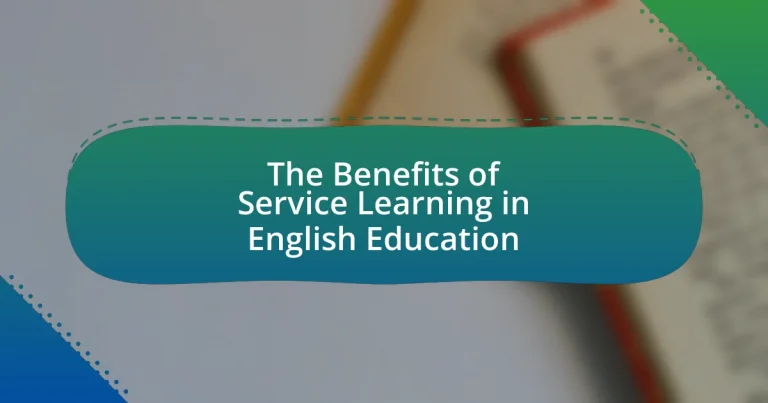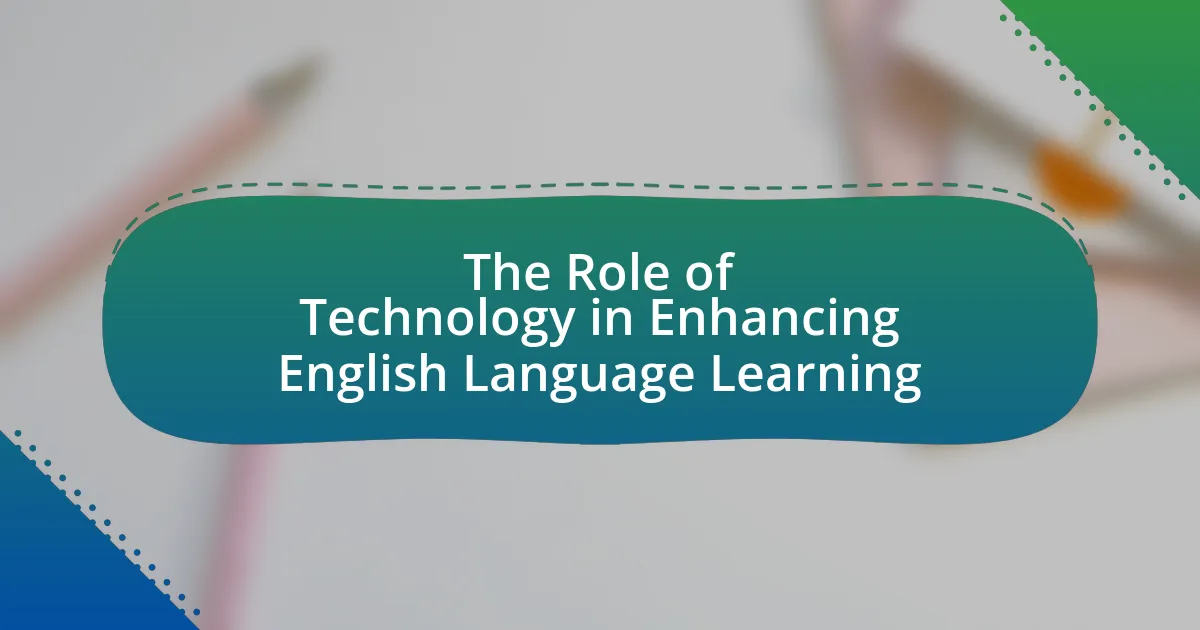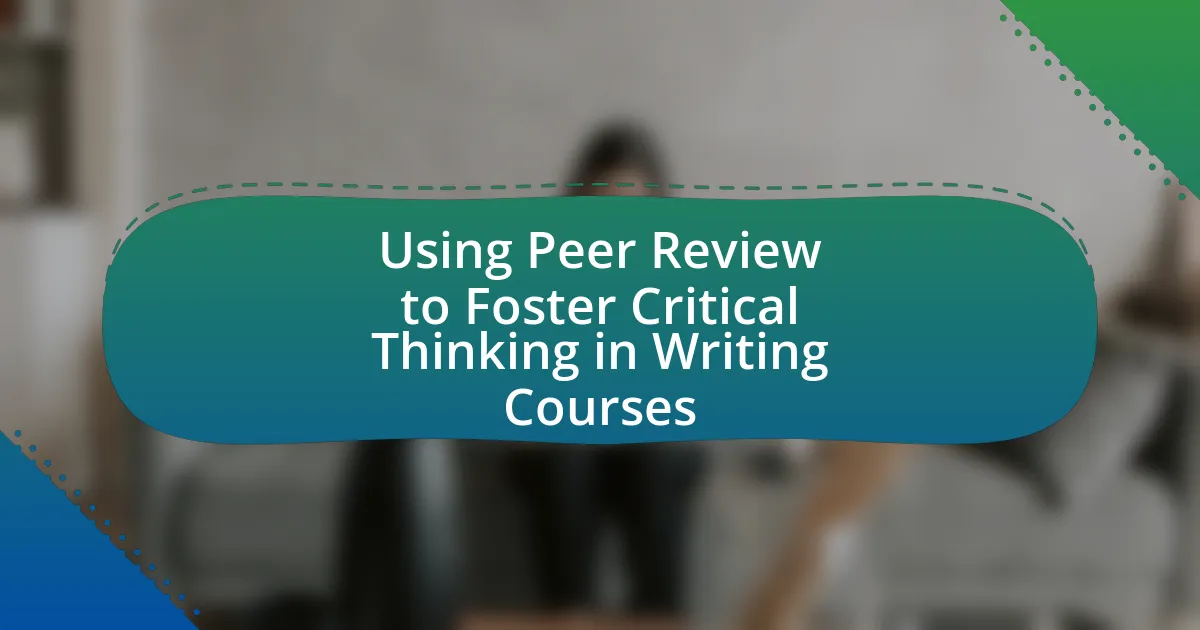The article focuses on the benefits of service learning in English education, highlighting its role in enhancing student engagement, language skills, and critical thinking. It discusses how participation in community service projects fosters communication, collaboration, and empathy among students, leading to improved academic performance and motivation. The article also outlines the importance of integrating service learning into the curriculum, the specific skills developed through this approach, and the long-term effects on students’ academic choices and career readiness. Additionally, it addresses the positive impact on communities, including enhanced literacy rates and stronger social ties.
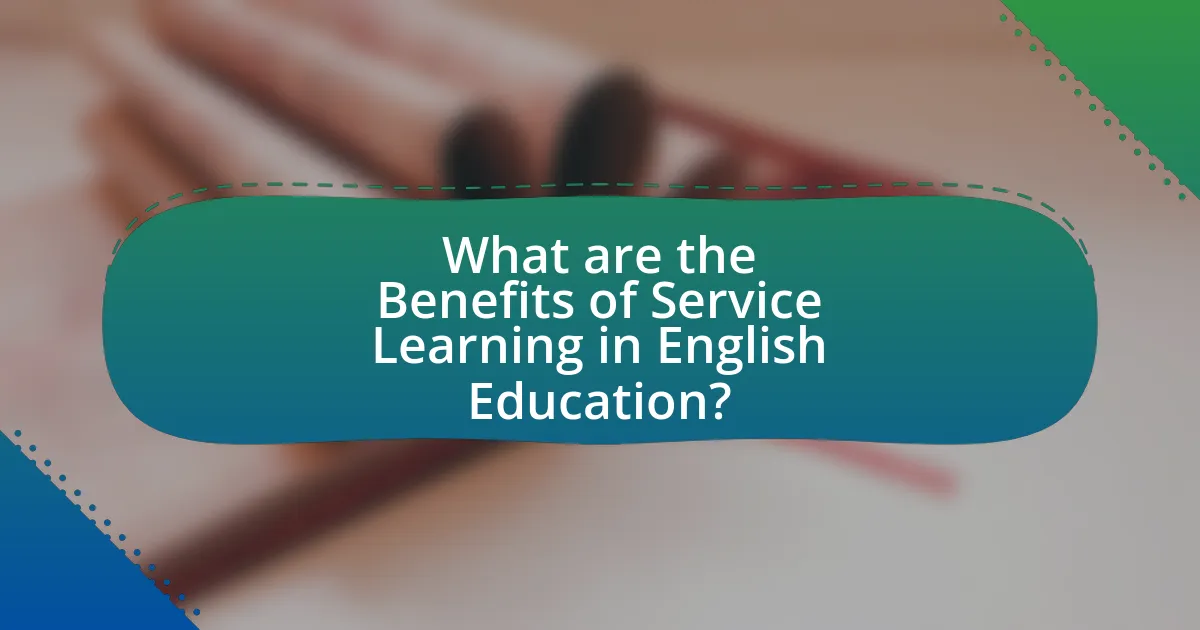
What are the Benefits of Service Learning in English Education?
Service learning in English education enhances student engagement and improves language skills through practical application. By participating in community service projects, students develop critical thinking, communication, and collaboration skills, which are essential for effective language use. Research indicates that students involved in service learning demonstrate higher academic achievement and increased motivation, as they see the real-world impact of their learning. For instance, a study published in the “Journal of Experiential Education” found that students who engaged in service learning showed a 20% improvement in writing proficiency compared to their peers who did not participate. This evidence underscores the significant benefits of integrating service learning into English education.
How does Service Learning enhance student engagement in English classes?
Service Learning enhances student engagement in English classes by providing real-world contexts for language use and fostering a sense of community involvement. This experiential learning approach allows students to apply their English skills in meaningful ways, such as through writing projects, presentations, or discussions that address community needs. Research indicates that students participating in Service Learning report higher levels of motivation and interest in their coursework, as they see the relevance of their studies to real-life situations. For instance, a study by Eyler and Giles (1999) found that students engaged in Service Learning demonstrated improved academic performance and greater retention of course material, highlighting the effectiveness of this method in enhancing engagement.
What specific skills do students develop through Service Learning in English education?
Students develop critical thinking, communication, collaboration, and empathy through Service Learning in English education. Critical thinking is enhanced as students analyze real-world issues and reflect on their experiences. Communication skills improve through writing and presenting their service projects, allowing them to articulate their thoughts effectively. Collaboration is fostered as students work in teams to address community needs, promoting teamwork and interpersonal skills. Empathy is cultivated by engaging with diverse populations, helping students understand different perspectives and social issues. These skills are essential for academic success and personal development, as evidenced by studies showing that Service Learning positively impacts student engagement and learning outcomes.
How does Service Learning promote critical thinking in English learners?
Service Learning promotes critical thinking in English learners by engaging them in real-world problem-solving and reflective practices. This experiential learning approach encourages students to analyze complex social issues, fostering deeper understanding and critical evaluation of their own perspectives and those of others. Research indicates that students involved in Service Learning demonstrate enhanced critical thinking skills, as they must assess community needs, develop solutions, and reflect on their experiences, which aligns with findings from the National Service-Learning Clearinghouse that highlight improved cognitive skills among participants.
Why is Service Learning important for community involvement in English education?
Service learning is important for community involvement in English education because it fosters real-world application of language skills while promoting civic responsibility. By engaging students in projects that address community needs, service learning enhances their understanding of social issues and improves their communication abilities. Research indicates that students participating in service learning demonstrate higher levels of engagement and retention of knowledge, as evidenced by a study published in the “Journal of Higher Education Outreach and Engagement,” which found that 85% of students reported improved writing skills and increased motivation to learn. This integration of service and learning not only benefits students academically but also strengthens community ties, making it a vital component of English education.
What role does Service Learning play in fostering social responsibility among students?
Service Learning plays a crucial role in fostering social responsibility among students by integrating community service with academic learning. This experiential approach encourages students to engage with real-world issues, promoting empathy and civic engagement. Research indicates that students involved in Service Learning demonstrate increased awareness of social issues and a commitment to community involvement, as evidenced by a study published in the Journal of Higher Education Outreach and Engagement, which found that 85% of participants reported a greater sense of social responsibility after completing Service Learning projects.
How can Service Learning projects address community needs through English education?
Service Learning projects can address community needs through English education by integrating real-world issues into the curriculum, allowing students to apply their language skills in meaningful contexts. For instance, students can engage in projects that involve tutoring non-native speakers, which not only enhances their own language proficiency but also meets the community’s demand for language support. Research indicates that such projects improve students’ academic performance and civic engagement, as evidenced by a study published in the “Journal of Higher Education Outreach and Engagement,” which found that 85% of participants reported increased awareness of community issues and a desire to contribute positively. This demonstrates that Service Learning effectively connects English education with community needs, fostering both educational and social benefits.
What impact does Service Learning have on academic performance in English?
Service Learning positively impacts academic performance in English by enhancing student engagement and improving language skills. Research indicates that students participating in Service Learning programs demonstrate higher levels of motivation and a deeper understanding of course material. For instance, a study published in the “Journal of Educational Psychology” by Eyler and Giles (1999) found that students involved in Service Learning showed significant improvements in critical thinking and writing skills compared to their peers who did not participate. This correlation suggests that the experiential learning component of Service Learning fosters a more effective learning environment for English language acquisition.
How does participation in Service Learning correlate with improved writing skills?
Participation in Service Learning significantly correlates with improved writing skills by providing students with real-world contexts that enhance their writing through practical application. Engaging in Service Learning allows students to write for authentic audiences, which fosters a sense of purpose and relevance in their writing tasks. Research conducted by Eyler and Giles (1999) indicates that students involved in Service Learning demonstrate higher levels of engagement and motivation, leading to improved writing proficiency. Additionally, the reflective component of Service Learning encourages students to critically analyze their experiences and articulate their thoughts more effectively, further enhancing their writing capabilities.
What evidence supports the effectiveness of Service Learning in enhancing reading comprehension?
Service Learning has been shown to enhance reading comprehension through various studies that demonstrate its positive impact on student engagement and learning outcomes. For instance, a study by Billig (2000) found that students participating in Service Learning programs exhibited improved reading skills and comprehension levels compared to their peers in traditional learning environments. Additionally, research conducted by Eyler and Giles (1999) indicated that students involved in Service Learning not only developed better literacy skills but also demonstrated increased motivation and a deeper understanding of the material, as they applied their reading skills in real-world contexts. These findings collectively support the effectiveness of Service Learning in enhancing reading comprehension among students.
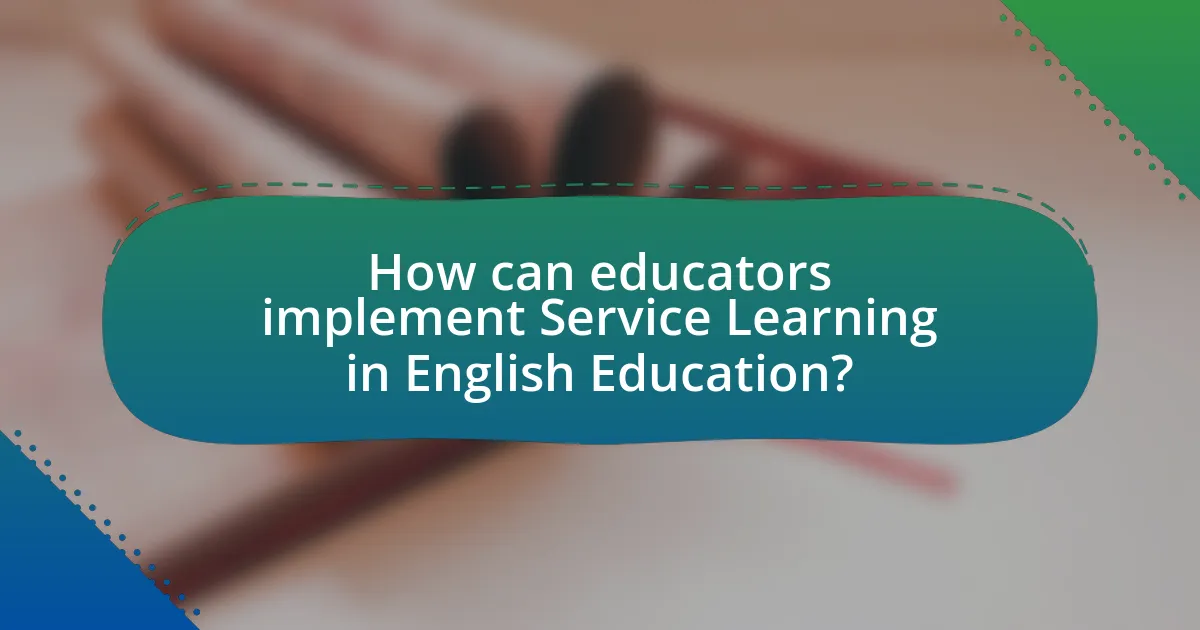
How can educators implement Service Learning in English Education?
Educators can implement Service Learning in English Education by integrating community service projects that align with the curriculum, allowing students to apply their language skills in real-world contexts. This approach enhances students’ engagement and understanding of the material while fostering civic responsibility. For instance, educators can partner with local organizations to create projects where students write and publish articles, conduct interviews, or develop presentations that address community needs. Research indicates that students involved in Service Learning demonstrate improved academic performance and greater retention of knowledge, as evidenced by a study published in the “Journal of Higher Education Outreach and Engagement,” which found that 85% of participants reported enhanced critical thinking skills through such experiential learning opportunities.
What are the key steps for integrating Service Learning into the English curriculum?
The key steps for integrating Service Learning into the English curriculum include identifying community needs, aligning service projects with curriculum goals, developing partnerships with local organizations, designing reflective activities, and assessing student learning outcomes. Identifying community needs ensures that the service projects are relevant and impactful, while aligning these projects with curriculum goals helps to reinforce academic objectives. Developing partnerships with local organizations facilitates resource sharing and enhances the authenticity of the learning experience. Designing reflective activities encourages students to critically analyze their experiences and connect them to their academic learning. Finally, assessing student learning outcomes allows educators to evaluate the effectiveness of the integration and make necessary adjustments for future iterations.
How can teachers identify suitable community partners for Service Learning projects?
Teachers can identify suitable community partners for Service Learning projects by assessing the alignment of community needs with educational objectives. This involves researching local organizations, such as non-profits or community service groups, that address relevant social issues and can provide meaningful engagement opportunities for students. For instance, a study by the National Service-Learning Clearinghouse indicates that partnerships with organizations focused on education, health, or environmental sustainability often yield successful outcomes in student learning and community impact. By evaluating the mission and activities of potential partners, teachers can ensure that the collaboration enhances both student learning and community benefit.
What resources are available to support Service Learning initiatives in English education?
Resources available to support Service Learning initiatives in English education include community partnerships, curriculum guides, funding opportunities, and professional development programs. Community partnerships, such as collaborations with local organizations, provide real-world contexts for students to apply their English skills. Curriculum guides, like those from the National Service-Learning Clearinghouse, offer structured frameworks for integrating service learning into English classes. Funding opportunities, such as grants from the Corporation for National and Community Service, help finance service projects. Professional development programs, including workshops and online courses, equip educators with strategies to effectively implement service learning in their classrooms. These resources collectively enhance the effectiveness and reach of Service Learning initiatives in English education.
What challenges might educators face when implementing Service Learning?
Educators may face several challenges when implementing Service Learning, including logistical issues, curriculum integration, and student engagement. Logistical issues often arise from coordinating community partnerships, scheduling, and resource allocation, which can complicate the execution of service projects. Curriculum integration poses a challenge as educators must align service activities with educational objectives, ensuring that learning outcomes are met while maintaining the integrity of the service experience. Additionally, fostering student engagement can be difficult, as some students may lack motivation or interest in community service, which can hinder the overall effectiveness of the program. These challenges are documented in research, such as the study by Billig (2000), which highlights the complexities educators encounter in balancing service and learning components effectively.
How can teachers overcome resistance to Service Learning from students or parents?
Teachers can overcome resistance to Service Learning from students or parents by actively engaging them in the planning and implementation process. Involving students and parents in discussions about the benefits of Service Learning, such as enhanced critical thinking skills and community engagement, can foster a sense of ownership and reduce apprehension. Research indicates that when stakeholders understand the positive impacts, such as improved academic performance and social responsibility, they are more likely to support these initiatives. For instance, a study by Eyler and Giles (1999) found that students who participated in Service Learning reported higher levels of engagement and satisfaction with their education, which can help alleviate concerns from both students and parents.
What strategies can be employed to assess student learning in Service Learning projects?
To assess student learning in Service Learning projects, educators can employ strategies such as reflective journals, peer assessments, and community feedback. Reflective journals encourage students to articulate their learning experiences and insights, fostering critical thinking and self-assessment. Peer assessments allow students to evaluate each other’s contributions and learning, promoting collaborative learning and accountability. Community feedback provides external validation of student efforts and impacts, ensuring that learning is aligned with real-world applications. Research indicates that these strategies enhance student engagement and deepen understanding, as evidenced by studies showing improved academic performance and civic responsibility among participants in Service Learning initiatives.
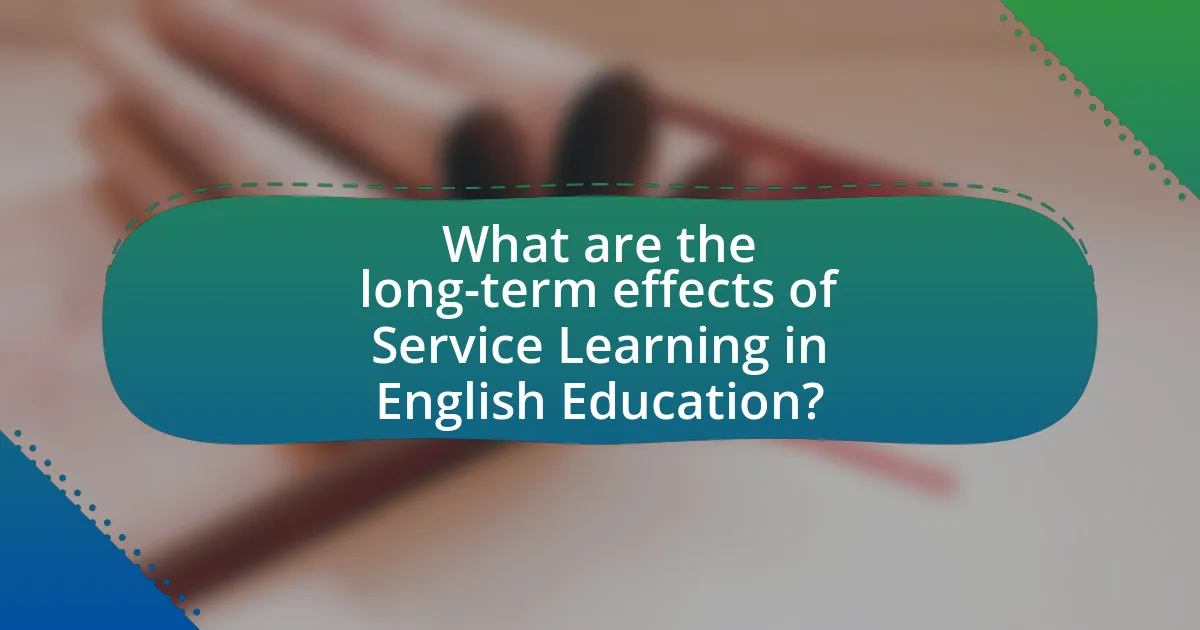
What are the long-term effects of Service Learning in English Education?
The long-term effects of Service Learning in English Education include enhanced critical thinking skills, improved academic performance, and increased civic engagement among students. Research indicates that students who participate in Service Learning develop a deeper understanding of course material, as they apply their learning in real-world contexts, which fosters critical analysis and problem-solving abilities. A study by Eyler and Giles (1999) found that students engaged in Service Learning demonstrated higher levels of academic achievement and retention of knowledge compared to their peers who did not participate. Additionally, Service Learning promotes a sense of social responsibility, leading to greater involvement in community service and civic activities long after the educational experience has concluded. This connection between academic learning and community engagement cultivates lifelong learners who are more likely to contribute positively to society.
How does Service Learning influence students’ future academic choices?
Service learning significantly influences students’ future academic choices by enhancing their engagement and motivation towards learning. Research indicates that students who participate in service learning often develop a clearer understanding of their academic interests and career aspirations, as they connect classroom knowledge with real-world applications. For instance, a study published in the “Journal of Higher Education” by Eyler and Giles found that students involved in service learning reported increased interest in their fields of study and a greater likelihood of pursuing related academic paths. This connection between service experiences and academic choices fosters a sense of purpose and direction, ultimately guiding students toward more informed and committed educational pursuits.
What impact does Service Learning have on students’ career readiness in English-related fields?
Service learning significantly enhances students’ career readiness in English-related fields by providing practical experience that aligns academic learning with real-world applications. This experiential learning approach allows students to develop essential skills such as communication, critical thinking, and teamwork, which are highly valued by employers. Research conducted by the National Service-Learning Clearinghouse indicates that students engaged in service learning report increased confidence in their abilities and a greater understanding of professional expectations. Furthermore, a study published in the Journal of Higher Education found that service learning participants demonstrated improved job readiness and employability skills compared to their peers who did not participate in such programs.
How can Service Learning experiences shape students’ perspectives on literacy and communication?
Service Learning experiences can significantly shape students’ perspectives on literacy and communication by providing real-world contexts that enhance their understanding and application of these skills. Engaging in community service projects allows students to practice literacy and communication in diverse settings, fostering critical thinking and adaptability. Research indicates that students involved in Service Learning demonstrate improved writing and speaking skills, as they must articulate their ideas effectively to various audiences. For instance, a study published in the “Journal of Higher Education Outreach and Engagement” by Eyler and Giles found that students participating in Service Learning reported increased confidence in their communication abilities and a deeper appreciation for the role of literacy in community engagement. This hands-on approach not only reinforces academic learning but also cultivates a sense of social responsibility, ultimately transforming students’ views on the importance of effective communication and literacy in their lives and communities.
What lasting benefits do communities experience from Service Learning in English education?
Communities experience enhanced social cohesion and improved literacy rates as lasting benefits from Service Learning in English education. Service Learning fosters collaboration between students and community members, leading to stronger relationships and a sense of belonging. Additionally, research indicates that programs integrating service projects with English education can significantly boost literacy skills; for instance, a study by the National Service-Learning Clearinghouse found that students participating in such programs showed a 20% increase in reading proficiency compared to their peers. This dual impact of social and educational improvement underscores the effectiveness of Service Learning in fostering community development.
How does Service Learning contribute to building stronger community ties through literacy initiatives?
Service Learning enhances community ties through literacy initiatives by fostering collaboration between students and local organizations. This experiential learning approach engages students in real-world literacy projects, such as tutoring or organizing reading programs, which directly address community needs. Research indicates that such initiatives not only improve literacy rates but also strengthen social bonds, as participants build relationships with diverse community members. For example, a study by the National Service-Learning Clearinghouse found that students involved in service learning reported increased civic engagement and a greater sense of belonging within their communities.
What role does Service Learning play in promoting lifelong learning among students?
Service Learning plays a crucial role in promoting lifelong learning among students by integrating meaningful community service with academic instruction. This experiential learning approach encourages students to apply their knowledge in real-world contexts, fostering critical thinking and problem-solving skills essential for continuous personal and professional development. Research indicates that students engaged in Service Learning demonstrate higher levels of civic engagement and social responsibility, which are key components of lifelong learning. For instance, a study published in the Journal of Higher Education found that students participating in Service Learning reported increased motivation to learn and a greater understanding of course material, reinforcing the connection between service and academic growth.
What best practices should educators follow for successful Service Learning in English Education?
Educators should implement structured reflection, community partnerships, and clear learning objectives for successful Service Learning in English Education. Structured reflection allows students to critically analyze their experiences, enhancing their understanding of course material and community issues. Community partnerships provide real-world contexts for learning, fostering engagement and relevance in English education. Clear learning objectives ensure that students understand the academic and social goals of the service project, aligning their efforts with educational standards. Research indicates that these practices lead to improved student outcomes, including increased civic engagement and enhanced literacy skills.
